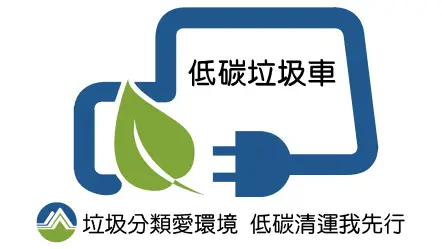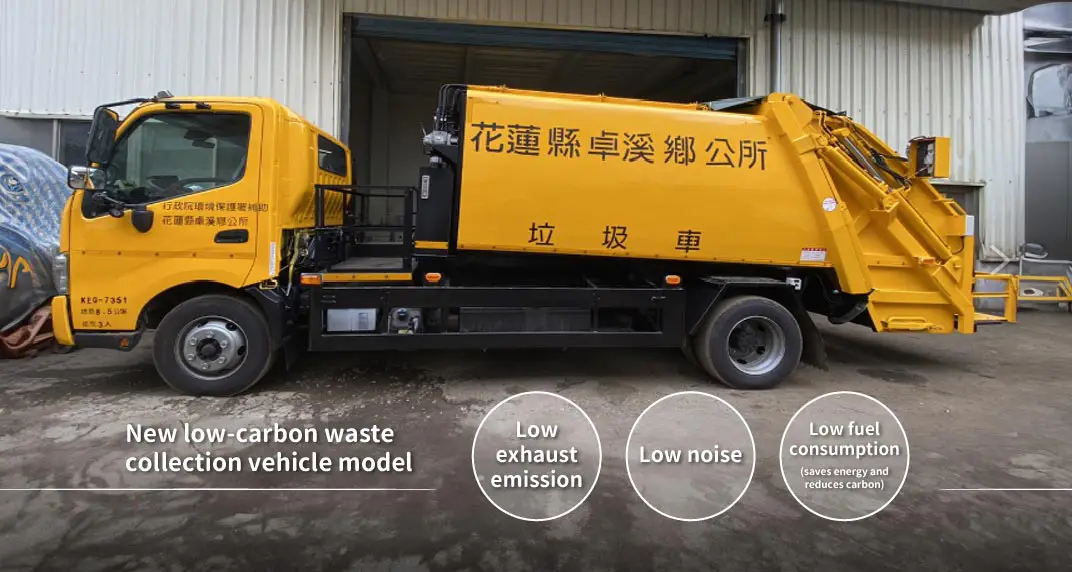 Low-Carbon Garbage Truck Initiative
Low-Carbon Garbage Truck Initiative

In everyday life, garbage trucks are responsible for collecting household waste. Their operation primarily involves designated roadside collection points, which results in frequent starting and stopping, leading to high fuel consumption and significant carbon emissions. Most traditional garbage trucks use diesel engines, which not only have low energy efficiency but also produce exhaust emissions and noise, becoming issues of environmental concern and occupational safety.
To respond to international trends in energy conservation and carbon reduction and to improve the working environment and safety of sanitation workers, the Ministry of Environment (MOENV) is promoting a low-carbon garbage truck policy. Through ongoing financial subsidies and procurement systems, it encourages local governments to replace old vehicles and adopt low-carbon collection equipment, moving toward greener and more sustainable waste collection operations.
To reduce the carbon emissions and noise generated by garbage trucks during driving and operation, two types of low-carbon garbage truck technologies are being introduced. By addressing power sources and vehicle weight, the energy-saving efficiency of waste collection operations is significantly improved.
- Electric Compactor Garbage Trucks: these trucks combine electric compacting technology with traditional garbage trucks, allowing the diesel engine to be turned off during collection stops, using electric power for compacting instead. This achieves zero idling, zero emissions, and reduced noise during compacting.
- Lightweight Garbage Trucks: these trucks use a lightweight chassis in place of the conventional engine-powered compactor garbage truck design. For a 6-cubic-meter garbage truck, the lightweight truck can use a chassis weighing between 8.55 to 9.5 tons, resulting in a total unladen weight of 5 to 5.3 tons. This is up to 23% lighter than traditional trucks, which typically use a 10.4-ton chassis (with an unladen weight of 6.1 to 6.5 tons), thus achieving energy-saving and carbon-reduction benefits.
To assist local governments in updating high-emission or outdated garbage trucks, the MOENV has established a joint supply contract system and promoted comprehensive replacement and upgrades through subsidy resources, enabling stable integration of low-carbon vehicles into waste collection fleets.
- Joint supply contract system: “sealed compression garbage trucks (low-carbon garbage trucks)” are included in government procurement contracts. From 2024, an 8-camera vehicle imaging system is added to enhance driving and operational safety monitoring.
- Subsidizing local garbage truck replacement: since 2016, subsidies have been promoted. In 2023–2024, 275 vehicles were subsidized, with funding totaling NT$477 million. In 2025, another 95 vehicles are subsidized, amounting to NT$155 million, with continued purchases supported by local budgets.
Sanitation workers stand on the rear of the truck for daily garbage collection tasks. To enhance their operational safety, the MOENV has strengthened anti-fall devices and visual monitoring systems on garbage trucks to reduce occupational risks.
- Installation of anti-fall bars behind vehicles: since 2018, 375 garbage trucks have been retrofitted. In 2025, another 100 vehicles are expected to be equipped. The installation rate of anti-fall devices on vehicles requiring rear standing positions has reached 83%.
- Enhanced safety monitoring through imaging systems: procurement contracts now include an 8-camera vehicle body design, which reduces blind spots and prevents accidents, enhancing real-time safety at the worksite.

Nationwide, there are now 1,864 low-carbon garbage trucks (with 1,084 subsidized by the administration and 780 purchased by local governments). From 2014 to 2024, approximately 11.02 million liters of fuel have been saved and 31,700 tons of carbon emissions reduced.
The subsidy policy and promotion of low-carbon garbage trucks have yielded significant results. With continued efforts by the administration, low-carbon garbage trucks now make up 23.6% of garbage collection operations nationwide. In the future, the administration will persist in advancing the adoption of low-carbon transportation to further contribute to environmental protection efforts.
- Data Source: Division of Environmental Sanitation
- Publish Date: 2024-08-27
- Update Date: 2025-11-06

 Related Topics
Related Topics






